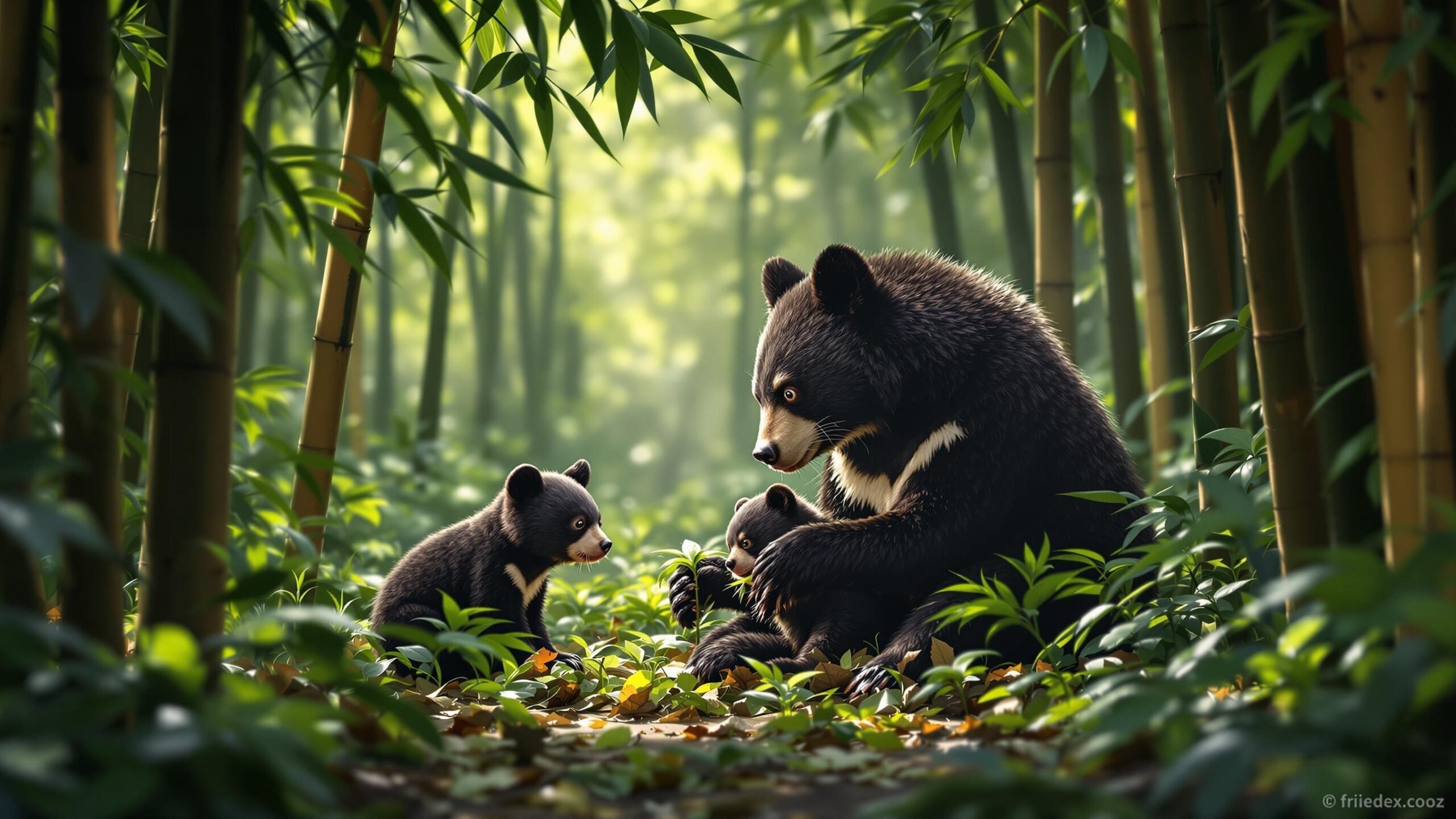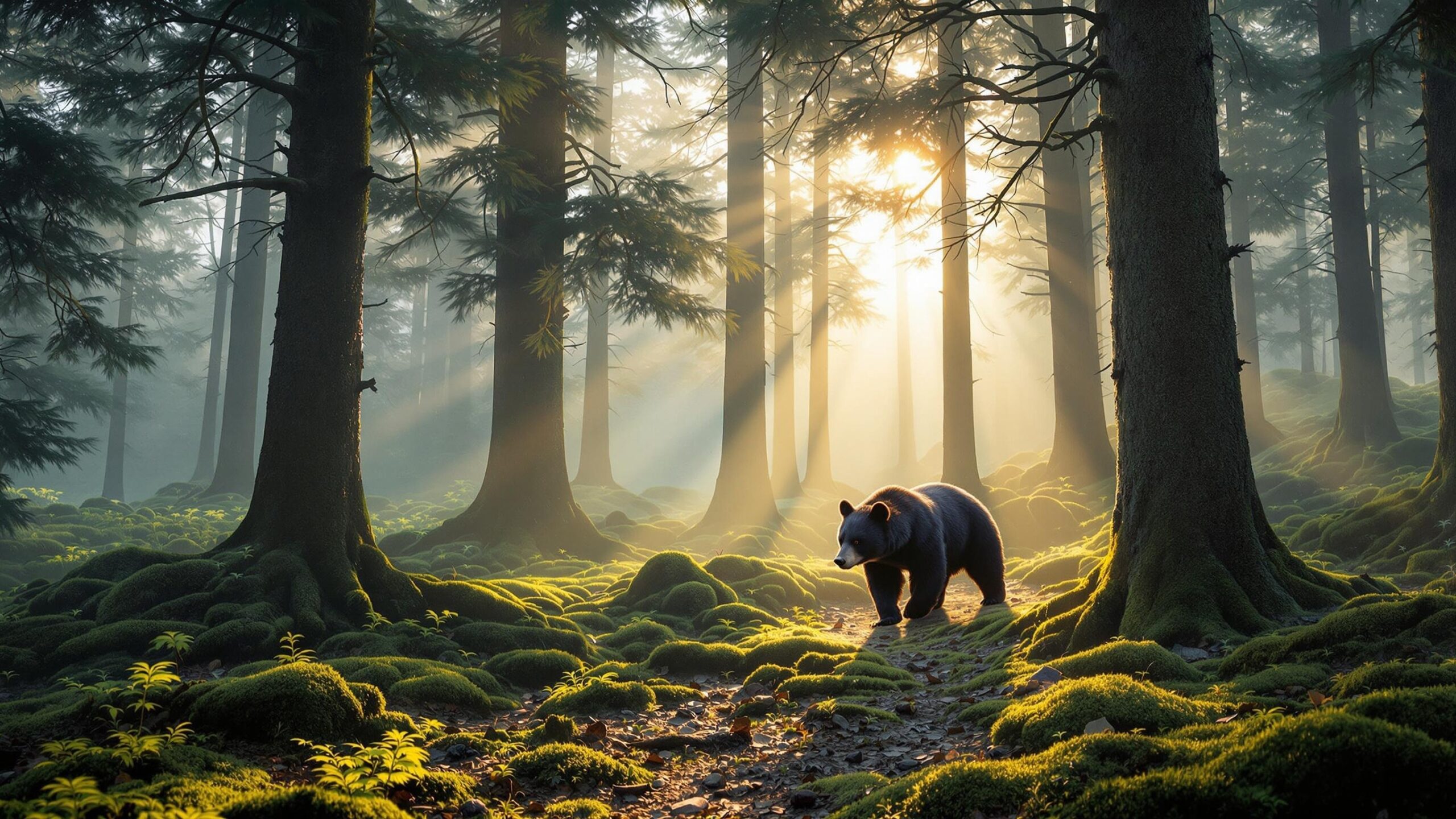Japanese Black Bear (Ursus thibetanus japonicus): The Elusive Guardian of Japan’s Forests
In the ancient, moss-laden forests of Japan’s mountains, a shy and solitary creature moves with quiet purpose. Rarely seen yet deeply connected to the country’s natural and cultural heritage, the Japanese Black Bear (Ursus thibetanus japonicus) is a symbol of wildness on an island nation shaped by civilization and tradition. A subspecies of the Asiatic black bear, this animal is native only to the Japanese archipelago, particularly the main islands of Honshu and Shikoku. Though small in size compared to other bears, its role in Japan’s forest ecosystems is vast—and its story is one of both resilience and rising concern. This comprehensive guide takes you into the world of the Japanese Black Bear, revealing its unique traits, behaviors, ecological significance, cultural symbolism, and the conservation efforts shaping its uncertain future.
Physical Characteristics: A Small but Hardy Bear
The Japanese Black Bear is one of the smallest members of the bear family. Adult males typically weigh between 120 to 250 pounds, while females are even lighter, often between 90 and 150 pounds. They have a compact, stocky build suited for Japan’s rugged mountain terrain, and are agile climbers despite their appearance. Their fur is typically jet-black, thick and glossy, with a distinctive cream-colored crescent or “moon mark” on the chest—a trait shared with other subspecies of Asiatic black bears.
The head is relatively small with a pointed snout and large, expressive ears. The paws are broad and powerful, with curved claws adapted for climbing trees and foraging in the forest floor. Although they are not the largest carnivores in Japan, their physical strength should not be underestimated, especially when defending themselves or their cubs. Despite their modest size, Japanese Black Bears possess a presence that commands respect. They are alert, intelligent, and deeply in tune with the subtle cues of their mountain environments.
Range and Habitat: Hidden Among the Hills
The Japanese Black Bear is found almost exclusively on the main islands of Honshu and Shikoku. Once more widespread across Japan, the species has disappeared from the northern island of Hokkaido and is now extinct on the southern island of Kyushu. Today, its primary habitats are in forested mountainous regions, particularly those covered in deciduous or mixed broadleaf forests, where seasonal food sources are abundant.
These bears are highly dependent on forest cover. They rely on dense, undisturbed woodland for shelter, nesting, and denning. The habitat is usually situated between elevations of 500 and 2,000 meters, though they may descend closer to human settlements in search of food, especially in autumn. The structure of Japanese forests, with their seasonal variations in mast-producing trees like beeches, oaks, and chestnuts, creates a complex and dynamic environment that the bears are well adapted to exploit. However, forest fragmentation and human development have increasingly pushed the bears into smaller, isolated pockets of wilderness.
Behavior and Lifestyle: Solitary and Stealthy
The Japanese Black Bear is primarily solitary, with the exception of mothers raising cubs or brief interactions during mating season. They are largely nocturnal or crepuscular, preferring to be active during the cooler hours of dawn, dusk, or nighttime. This behavior not only helps them avoid the heat of the day but also reduces the likelihood of encountering humans. These bears are seasonally mobile, adjusting their elevation and foraging patterns throughout the year. In spring and early summer, they consume fresh vegetation and insects. As autumn approaches, they intensify their feeding in preparation for hibernation, focusing on high-calorie foods like nuts and acorns.
They are skilled climbers, often ascending trees to access fruit or escape danger. Cubs are especially adept at tree climbing, and mothers often lead their young to elevated branches when sensing a threat. In colder parts of their range, Japanese Black Bears enter hibernation between November and April, choosing hollow trees, rock cavities, or dense undergrowth as dens. In milder regions, some may remain partially active through the winter, depending on local climate and food availability.

Diet: Omnivores with Seasonal Tastes
As omnivores, Japanese Black Bears have a highly varied diet that changes with the seasons. In spring, they feed on young shoots, grasses, herbs, and insects, which help replenish energy after hibernation. Summer brings access to berries, fruits, and small animals, while autumn is their most critical feeding period. During fall, bears enter a state called hyperphagia, where they consume thousands of calories daily to build fat for the winter. They rely heavily on mast-producing trees, such as beeches, oaks, and chestnuts. When mast is abundant, bears remain deep in the forest. When it fails—a phenomenon that occurs cyclically—they may descend into farmland or villages, leading to increased conflict with humans. While their diet is largely plant-based, they are also opportunistic. They may eat birds, eggs, carrion, or small mammals if easily available. In some cases, especially in lean years, they’ve been known to raid beehives or livestock pens.
Reproduction: New Life in the Den
The reproductive cycle of the Japanese Black Bear is both fascinating and delicately timed. Mating occurs between June and August, and after fertilization, the female experiences delayed implantation, a biological process where the fertilized egg does not immediately attach to the uterine wall. This allows her to continue foraging throughout the summer and fall.
If she accumulates enough fat by the time she enters hibernation, the embryo will implant and begin development. Cubs are born in the den during winter, typically around January or February. Litters usually consist of one to two cubs, though three are possible in food-rich environments. The cubs are born blind, hairless, and weighing less than a pound. They nurse throughout the winter and emerge with their mother in spring. She will care for them for about 18 months, during which time they learn to forage, climb, and avoid threats. The maternal bond is strong, and the cubs’ survival depends heavily on the mother’s health and knowledge of her home range.
Communication and Senses: Quiet Observers
Japanese Black Bears are generally quiet animals, but they communicate through a variety of means. Vocalizations include grunts, woofs, moans, and jaw-popping sounds, usually used to signal distress, warning, or communication between mother and cub. Cubs may whimper or squeak when calling out to their mother.
More often, they rely on scent and visual cues. Bears mark trees by scratching bark, rubbing their bodies, or biting trunks to signal territory and presence. These scent marks play a crucial role in preventing direct confrontations between individuals, which can be costly and dangerous. Their senses are finely attuned to their environment. They possess excellent hearing and a highly developed sense of smell, which they use to detect food and other animals across great distances. Their eyesight is less advanced but sufficient for navigating forest landscapes and identifying shapes.
Cultural Significance: A Creature of Myth and Memory
In Japanese folklore, the bear, or kuma, has long held a place of reverence and fear. It is both a symbol of strength and wilderness and, at times, a fearsome creature in rural legends. Some Shinto and Ainu traditions regard bears as sacred or as spiritual messengers. Ancient hunting rituals often paid respect to the bear’s spirit, acknowledging the balance between taking life and respecting it.
Throughout history, rural Japanese communities have passed down stories of bears protecting forests, guarding mountains, or embodying deities. These tales, while sometimes cautionary, also reflect a deeper connection to the bear as part of the natural world, not separate from it. In modern times, bears are often featured in literature, television, and animation—sometimes portrayed whimsically, other times as powerful creatures in the shadows of human expansion. This complex cultural portrayal mirrors the bear’s real-world relationship with Japanese society: part awe, part caution.
Human-Bear Interactions: Conflict and Coexistence
The proximity of bear habitat to human settlements in Japan has led to frequent interactions, especially in years when natural food sources are scarce. Bears may enter villages, raid crops, or wander into urban outskirts in search of sustenance. While many bears retreat at the first sign of humans, some become food-conditioned, losing their natural wariness. These encounters can sometimes turn tragic—for both bears and people. In response, various prefectures have employed methods ranging from deterrent devices and relocation programs to culling, especially when public safety is at risk.
At the same time, efforts to promote coexistence are growing. Bear-safe garbage systems, educational outreach, and community-led forest management are helping reduce conflict. In some areas, non-lethal management practices, such as bear bells and motion-activated alarms, are proving effective. Ecotourism and wildlife watching initiatives, though less developed than in some countries, are also beginning to emerge, offering new ways to appreciate bears in their natural habitats without harm.
Conservation Status: At a Crossroads
The Japanese Black Bear is listed as Vulnerable by the Japanese Ministry of the Environment and is included in the Red Data Books of various prefectures. Habitat fragmentation, food shortages, and increasing human-wildlife conflict all contribute to declining and isolated populations. The population in Shikoku is especially critical, with only an estimated 20–30 individuals remaining, making it one of the most endangered large mammals in Japan. On Honshu, the situation is somewhat better, but trends show uneven recovery and continued threats.
Conservation efforts include the establishment of protected areas, ecological corridors, and government-supported monitoring. NGOs and universities conduct research on bear movement, genetics, and population trends, providing valuable data for policy decisions. Public awareness is key. By fostering a culture of respect, understanding, and responsibility, Japan has the potential to preserve its only native bear species for future generations.

Ecological Role: Forest Keepers of the Archipelago
The Japanese Black Bear plays an important ecological role in maintaining forest health and diversity. As seed dispersers, they help regenerate forests by consuming fruits and nuts and spreading seeds over wide areas through their droppings. Their foraging behavior, especially their habit of climbing and breaking branches, contributes to forest floor light gaps that support understory plant growth. By preying on insects and scavenging carrion, they also contribute to nutrient cycling and pest control. In essence, these bears are keystone species—their presence, though quiet and often unseen, supports the very structure and balance of the ecosystems they inhabit.
A Living Link to Wild Japan
The Japanese Black Bear is more than a biological curiosity—it is a living link to Japan’s wild past and a test of its environmental future. Small, stealthy, and mysterious, it symbolizes the resilience of nature in a densely populated and highly developed nation. It asks a simple but profound question: can wildness endure in a world of roads, cities, and convenience? By protecting the bear, Japan protects its forests, its biodiversity, and a part of its soul that still listens to the rustle of leaves and the distant snap of a twig. With continued effort, thoughtful policy, and public engagement, the shadow of the Japanese Black Bear will continue to move silently through the woods—watching, waiting, and reminding us of what still remains wild.

